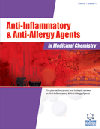- Home
- A-Z Publications
- Anti-Inflammatory & Anti-Allergy Agents in Medicinal Chemistry (Formerly Current Medicinal Chemistry - Anti-Inflammatory and Anti-Allergy Agents)
- Previous Issues
- Volume 16, Issue 2, 2017
Anti-Inflammatory & Anti-Allergy Agents in Medicinal Chemistry (Formerly Current Medicinal Chemistry - Anti-Inflammatory and Anti-Allergy Agents) - Volume 16, Issue 2, 2017
Volume 16, Issue 2, 2017
-
-
Anti-inflammatory and Antioxidant Agents from Salvia Genus (Lamiaceae): An Assessment of the Current State of Knowledge
More LessBackground: Salvia species are known for their biological properties in many countries and might potentially provide novel therapeutic agents. This review provides an overview of the available literature on the anti-inflammatory and antioxidant effects of Salvia species. Methods: Using bibliographic databases, particularly PubMed, this review aims to add new information to the list of Salvia species, including S. ceratophy Read More
-
-
-
Inflammatory and Oxidative Stress Markers as Indicator of Atherogenesis in Rats: Antioxidants as Preventive Pharmacological Methods
More LessObjective: The oxidative process in atherogenesis generated by proinflammatory induction and response to antioxidants vitamins in an experimental model were analyzed. Methods: Male rats were used: (A)Control, (B)Control+vitamin E plus C, (C)Hyperfibrinogenemia and (D)Hyperfibrinogenemia+vitamins E plus C. Hyperfibrinogenemia induced by daily injection of adrenaline (0.1mg/day/rat) for 120 days. T Read More
-
-
-
Evaluation of in vitro Anti-psoriatic Activity of a Novel Polyherbal Formulation by Multiparametric Analysis
More LessBackground: We have developed a novel aqueous polyherbal formulation (SIRB-001) consisting of 3 herbs; Rheum palmatum L., Lonicera Japonica and Rehmannia glutinosa Libosch in the ratio 1:1:3. SIRB-001 has demonstrated efficacious effects in psoriasis patients. Objective: This study was aimed at scientifically evaluating the in vitro antipsoriatic activity of SIRB-001. Method: The in vitro anti-psoriatic properties of SIRB-001 Read More
-
-
-
Anti-Inflammatory Activity of Novel 12-N-methylcytisine Derivatives
More LessBackground and Objectives: Neurodegenerative diseases and inflammation are always linked to each other; therefore the elaboration of new chemical compounds, which interact with pharmacological targets involved into these two processes, can become one of ways of correction of these types of human CNS pathology. In the field of this problem the anti-inflammatory activity of ten 3-amino derivatives of quinolizidin Read More
-
-
-
Bisthiourea Derivatives of Dipeptide Conjugated Benzo[d]isoxazole as a New Class of Therapeutics: Synthesis and Molecular Docking Studies
More LessBackground: Studies on anti-inflammatory and antimicrobial agents remains a challenging and important area in medicinal chemistry research due to more toxic and rapid development of resistance against first effective drugs. In search of novel anti-inflammatory and antimicrobials agents, bisthiourea derivatives of dipeptide conjugated to 6-fluoro-3- (piperidin-4-yl)benzo[d]isoxazole were synthesized. Methods: The peptides Read More
-
Volumes & issues
-
Volume 24 (2025)
-
Volume 23 (2024)
-
Volume 22 (2023)
-
Volume 21 (2022)
-
Volume 20 (2021)
-
Volume 19 (2020)
-
Volume 18 (2019)
-
Volume 17 (2018)
-
Volume 16 (2017)
-
Volume 15 (2016)
-
Volume 14 (2015)
-
Volume 13 (2014)
-
Volume 12 (2013)
-
Volume 11 (2012)
-
Volume 10 (2011)
-
Volume 9 (2010)
-
Volume 8 (2009)
-
Volume 7 (2008)
-
Volume 6 (2007)
-
Volume 5 (2006)
Most Read This Month
Article
content/journals/aiaamc
Journal
10
5
false
en


